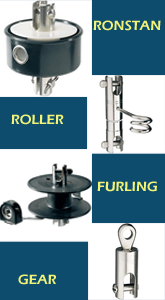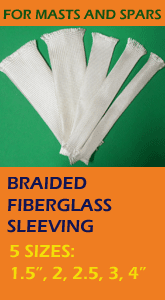
 Custom Search
|
| boat plans |
| canoe/kayak |
| electrical |
| epoxy/supplies |
| fasteners |
| gear |
| gift certificates |
| hardware |
| hatches/deckplates |
| media |
| paint/varnish |
| rope/line |
| rowing/sculling |
| sailmaking |
| sails |
| tools |
| join |
| home |
| indexes |
| classifieds |
| calendar |
| archives |
| about |
| links |
| Join Duckworks Get free newsletter CLICK HERE |
|
|
| May Treasure Chest |
Composite Brads
This photo stolen from the Selway-Fisher Yahoo group is a good example of the use of traditional lapstrake clamps. Has anyone else tried using composite brads for this job? Chuck Phoenix III
This is what I did on a Phoenix 3. I put an abrasion resistant cloth on the bottom four planks and used a one and done release cloth to minimize resin weight it will also stiffen the bottom for walking At least no cracks so far. Jeff P Quick Cleat
I get a lot of PR material about new products - some silly and some actually on the verge of useful. the ones for boat polish or exhaust system winterizer I ignore but I will try to post ones like this for discussion. Is this cleat something Duckworks should stock? Chuck Clamps
Some handy clamps I knocked up using plans out of a Wooden Boat magazine article. Robert RinseKit
Interesting, could be useful when cruising if you've the space for it. Seth Oar Lock Socket DesignWhen I was building my row only Moby Dink, I decided to use the off fall from the oak I bought for the skeg for my oarlock sockets. I liked the design in Jim Michalak’s book ‘Boat Building for Beginners (and Beyond)’ that he got from Phil Bolger. In the book, he uses the wales for the base of the sockets. My Moby is the row version with a thinner wale so I had to use oak blocks. I also added nylon bushings inside the sockets for a smother bearing. Two #10 oval head screws and thickened epoxy secure the sockets to the gunwales. The two drawings below show the details parts for my design:
Notice that the mounting holes in the aluminum plate are for the top plate only and are not shown on the oak part. This is because they are drilled on assembly. I used nylon bushings that are .625 outside diameter and .50 inch inside diameter. The hole in the oak is .625 for the outside of the bushing and the hole in the aluminum is .50 to retain the bushing. To assemble all of this and keep everything aligned, I used a .50 inch diameter bolt and nut to hold alignment as shown below.
The bolt goes through the bottom plate without the mounting holes with the nylon bushing in place. Then the top plate and the nut are added. I matched drilled through the oak and the bottom plate using the top plate mounting holes as guides. To finish, I used 10-32 screws secured with 10-32 nuts with red lock tight. Lots of silicone sealant used throughout. Bob Holley Pull Saws
Here are a couple of photos of the pull saw I recommended showing how they can be used to cut gentle curves in plywood. This could be a great help to folks cutting thin plywood when making small boats. Pullsaw 2312 is great for plywood that is 1/4 inch or smaller. Tom Hruby Stand-up paddle with Mirage Drive
Here's a new way of getting on the water. Hobie have combined the stand-up paddle board with their Mirage Drive units. Read more... Brian |
To comment on Duckworks articles, please visit one of the following:
|
 |

















